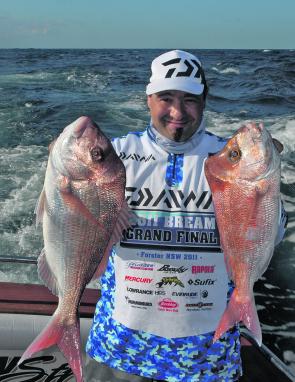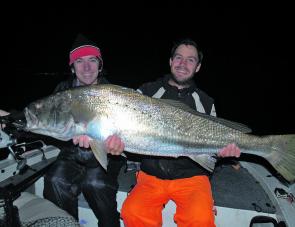September sees the water temperatures stay around 20-22ºC and, in general, the wider grounds fish well. Target species include snapper, pearl perch, amberjack, yellowtail kingies and samsonfish. The snapper start to decline a bit in numbers towards the end of the month as the spawning season tapers off.
Current permitting, it is also a good month to try fishing the deep canyons and drop-offs with electric reels targeting bass groper, bar cod and blue eye. The drop-off around Jims Mountain can be very good, and closer inshore some of the pinnacles in 70 fathoms produce some monster pearl perch as well as decent bar cod and big kingies.
Snapper fishing on the 36 fathom line has been quite good recently and plenty of quality 5-8kg fish have turned up at times. The reefs east of Jumpinpin and North Stadbroke Island have been the most productive. Float-lining with pilchards and deep soft plastics have been responsible for most of the better fish caught. There have also been quite a few 8-12kg cobia caught using the same methods. Putting out a live bait while float-lining for snapper is a very good option.
On the 50 fathom line there have been plenty of decent pearl perch and local charter boat Lucky Strike, skippered by Ross McCubbin has caught plenty of good fish over the past month in this area. Deep live baits fished on the 50 fathom line have been a great method for kingies and amberjacks. This area should also produce a few rosy jobfish and black banded pigfish this month. These are delicious eating. Try small pieces of squid on 2/0 hooks or lucanis jigs.
Closer inshore the 18 fathom line should produce a few mulloway and teraglin at night on live baits and the 24 fathom reef should still hold a few snapper. The artificial reefs to the north of the Seaway in 23m of water are worth a look for cobia this month. A bit of berley definitely helps, and these underwater boxes have been a great success in holding large schools of yellowtail and slimy mackerel. This area also produces some good mulloway at times with good fish over 15kg turning up on a regular basis.
For the game fisher, September can produce yellowfin tuna and striped marlin on the wide grounds. There are sometimes big schools of sauris at this time of year and the area around Jims Mountain and the hundred fathom line are worth a look. The fishing can be quite good when the bait is around.
Troll slightly smaller lures than are traditionally used for blue marlin and straight running jet heads that run a bit deeper are generally the best type of lure for big yellowfin tuna. Some years see reasonable numbers of striped marlin on the 36 and 50 fathom lines so it is worth putting the lures out and working this area for a while before heading out wider. There may also be the occasional blue marlin around, especially if the water temperature is above 22ºC.
This is the best month of the year to target flathead. The bigger fish start to move towards the entrances of Jumpinpin and the Seaway and large females over 80cm start to turn up in numbers on deep fished plastics, vibes and blades. A huge number of smaller males also congregate in this same area and all of these fish feed hard prior to and after spawning.
Try deep jigging and trolling using quite large lures this month. Few lures are too big! Years ago Peter Pakula had great success trolling massive Mann’s Stretch 30s in depth of 15m in the Seaway, and these lures are big enough to fillet! Deep plastics such as 6” Gulps, 150mm Squidgies and large Bozo curl-tails all work very well. The Gulp Nemesis is another good plastic to try and works well on mulloway and snapper as well as XOS flathead.
Further up the Broadwater the flats and channels from Tippler’s Passage through to Jumpinpin all fish well for flathead and blades, soft plastics and trolled hardbodies are all very effective. Catches of 20-40 fish per session are the norm in reasonable conditions. The bite tends to shut down markedly if a strong warm northwesterly starts to blow and this greatly reduces water clarity.
There are often algal blooms in September as the water warms and the algae found on eelgrass dies and drops into the water. This produces slimy weed that fouls lures and puts fish off the bite as well. In these conditions, look for cool clean water. The run-in tide adjacent to the entrances often fishes well in these conditions and gives short windows of clean water. Low flow area such as Tippler’s Passage and the various lagoons where there is minimal tidal flow are often the best areas to target in these conditions.
As the days warm up the mangrove jack start to go on the chew, and cast plastics, trolled hardbodies and live baits can all be effective. Floating pontoons provide jacks with good cover throughout the entire tide cycle and are very productive. Michael Horne is the local jack guru and his favourite strategy is to work the food spots with 4” Z-Man swimmers, the jack whisperer’s go-to weapon.
There will still be some good mulloway in the Seaway and around Jumpinpin and the winter fishing was very good. We got some decent fish on live mullet up to 22kg and in the day there have been some quality fish to 1m or so on plastics. Luke Glassington recently got a cracker 122cm in the Seaway on a 7” Gulp that took nearly an hour to land.
As a final note, the upcoming Flathead Classic marks the 20th year of this great event. I wish all competitors a great time and good fishing in what is now one of the largest and most popular fishing competitions in the country.
Reads: 2122
Snapper numbers will start to decline at the end of the month, so make the most of this great species at the beginning!

Kane and Michael with a cracking mulloway.

Don’t forget to sign up for the Flathead Classic. This year marks its 20th anniversary.




